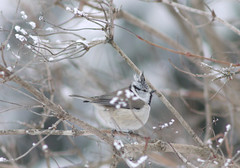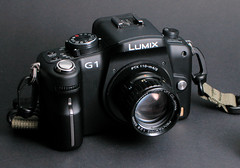 In complete contrast to my 4x5 camera the G1 has been in my hands for a little over a year and 10,000 images. That's some family events, funerals, christenings and general photographic coverage as well as HDRI experimentation.
In complete contrast to my 4x5 camera the G1 has been in my hands for a little over a year and 10,000 images. That's some family events, funerals, christenings and general photographic coverage as well as HDRI experimentation.Quite a stark contrast to the 4x5 in so many ways.
I think that this also high lights the difference between the two media (film vs digital).
Digital has definitely taken picture taking to an entirely new level. People take thousands of images per year where once upon a time they may have taken 2 or 3 rolls of film per year (so around a hundred).
Add to this the pressure to upgrade cameras to keep up with the megapixel race and long term ownership seems to be something almost unknown (and perhaps irrelevant).
Well, given that some people actually may consider their camera to be a purchase (rather than some form of subscription for a year) I thought that I would write briefly of my experiences with this camera in my first year of use.
I don't know if people consider that 10,000 images is many or not, but in 365 days that works out to be 27 pictures a day. Given that I don't use it every day I'd personally call that reasonable use, and certainly more than I used many of my previous cameras.
Usage
As I live in Finland the camera has been used in all manner of cold temperatures and snow. No problems (aside from normal precautions on coming back in to the warm) have been taken. So far the only thing I've noticed in the use in low temperatures was one day when it was -25C that after a few hours my EVF seemed to be showing the colours as mainly blue ... I didn't see this in the rear screen or later in the images, but the EVF does not like the extreme cold it seems.I've left it out overnight in -20C with no problems (keeping the battery in my pocket inside so that won't loose power).
I find that the interface of the camera is good, the EVF exceptional and the controls are laid out well and good to get at. I'm an older 35mm style photographer (as well as large format) and like physical switches and knobs not menus.
The only thing I'd bitch about is the Auto Exposure Brackting. After using EOS cameras for some time I love the way they set theirs up. I can pick how many EV spacing I want and place the center point + or - too. The G1 sucks in this department and you'll read a few complaints about that. My workaround for using HDRI is to put the camera in AV (to keep the same shutter) and then wind on the exposure compensation manually and take each shot with the shutter release.
Not good for working fast but its all you can do. Panasonic would do well to fix this as it really can't be a difficult thing to do.
When I bought the G1 I had begun a new personal philosophy of recognition that things like this are not items to obsess over, and are likely to be obsolete before they stop working. They also drop a lot in value from initial purchase, especially when new cameras come out with higher specifications (something which certainly did not happen to my Toho 4x5 camera).
I can say that while I did not make great efforts to 'baby' I did not actively attempt to destroy it either. So after a year of use without kid gloves, very little seems to have changed with my G1 in this time. I can say that the paint is wearing off the buttons on the back ...

but nothing dreadful.
The 'rubberised' finish the camera has is wearing off in one place, which I must say seems a strange spot.

I occasionally put it into a camera "snoot" case when transporting it in the car or in a backpack so perhaps its worn off on the inside of that ... funny that its only on this spot.
I use the camera effectively as a photographic tool, not restricting myself to just its standard 14-45 zoom ... for example this is the range of lenses I use on my G1

lenses like the 300mm look bigger on it than they really are:

and move this little camera out of the simple snapshot tinytot league into being a competent system for making great images of (difficult to catch) wildlife


great travel snaps

and even high quality panorama landscapes like this one

which at 8000pixels across makes a very lovely highly detailed 90cm wide print
So even after using it extensively with a variety of lenses (and adaptors to mount those lenses) it just keeps on keeping on as you would expect any tool to do.



its been well worth the 600 euro I paid for it with its standard lens and its worth pointing out I have not yet spent that much on all of the lenses I use with it.
while there has been some discussion on the net about the strap support lugs falling out of the GH1 I've personally not experienced anything like that, but I do keep an eye on them now and then to check for any sign of looseness
strengths
The camera is great for general photography, the standard (and therefore automated) lenses are able to produce great quality pictures. Its light on the shoulder and for the image quality and features light on the wallet.
weaknesses
Sports photography. This is not to say you can't do that with this camera, its just that if you're used to the levels of automation of focus that are provided by cameras like Nikon or Canon you'll be left with poor images and wondering why.
 The AF is not capable of doing high speed follow focus, so if you do motor sports or athletics or football you may be disappointed. Especially if you've used high end gear.
The AF is not capable of doing high speed follow focus, so if you do motor sports or athletics or football you may be disappointed. Especially if you've used high end gear.This is the only image I got from warmup on last nights floor ball with the G1.
It was taken with 800 ISO "wide open" (which of course at the tele end is f5.6 so not really open if you ask me). While the OIS did a good job of stabilising the image (1/60th of a sec on an effective 400mm if this was full frame) the foreground / background blur just isn't enough for my preferences to isolate the subject.
Quite a many of the images were simply too shakey to be good enough, and this one was the exception.
However in reality most photographers (despite hanging out at the photo shop and drooling) do not have access to lenses like Canon's Canon's EF300 f2.8 IS or EF 70-200 USM and (to be totally honest) most people do the opposite and buy a top camera like the EOS 50D then put on grubby 28-200 Tamron f5.6 zooms and wonder why their images are crap.
For a photographer who is used to manual focus, then the easy solution is to pop on an FD or other legacy lens such as an FD 200mm f2.8 and get it the way people used to do before AF became the norm. That would be 2 stops faster than the 45-200 lens and give you 250th of a sec in the above shot, maybe more given how much light loss I see on the 45-200. BTW, I bet you'd be surprised to find how many sports photographers still use their AF lenses on MF...
conclusion
great camera and great value for money. Easily one of the best cameras I've had.










3 comments:
I concur! Probably the best camera I've ever owned in terms of enjoyment and functionality. I find myself not craving any form of "upgrade" at all which after 16 months is a good sign.
What camera strap do you use, by the way?
Eric
my strap is a home brew arrangement. I took the green webbing parts you see from a rifle strap which is designed to detach. I then threaded in the ends of a more common neoprene neck strap I bought on ebay.
This gives me something I can take off on the tripod (where its annoying) and even leave around my neck so I don't loose it.
Thanks! Time to scrounge about to see what I can find.
Post a Comment